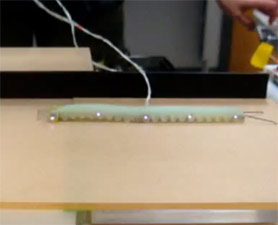 These crawling bots could one day explore tricky danger zones or aid in search-and-rescue operations.
These crawling bots could one day explore tricky danger zones or aid in search-and-rescue operations.
moves, escaping predators by curling into a wheel and rolling away, has been built by researchers from
These crawling bots could one day explore tricky danger zones or aid in search-and-rescue operations.
moves, escaping predators by curling into a wheel and rolling away, has been built by researchers from
"The most difficult part was getting it to actually do a roll," said Huai-Ti Lin, author of the new paper in Bioinspiration & Biomimetics. "There were a lot of trials, and a lot of sleeping in the lab. It was worth it. Once we got it to work, we optimized it and now we are matching the performance of the caterpillar."

The goal of building these kinds of nature-inspired robots is to design devices that can take on search-and-rescue missions in crumpled buildings or explore caves and crevasses for lost items
Lin and colleagues at
Click here to see the caterpillar robot in action.
Turns out that several kinds of critters -- including a nocturnal Saharan spider, a shrimp-like stomatapod that lives in
These movements take a lot of energy, but generate incredible speeds. Lin said he figured that using a rolling motion would allow the robot to cover greater terrain. The robot would also be able to explore tight spaces in a crawling mode.
"It's hard to get any speed out of crawling or inching," said Lin, now a postdoctoral researcher at
The field of robotics has long looked to nature for inspiration, especially when it comes to finding new ways to walk across uneven surfaces. Howie Choset, associate professor at
Choset says one of the biggest obstacles for this new class of robots is getting actuation, or motion, in three dimensions.
"We still need to build a robot that's capable of motions in confined spaces," Choset said from his office in
Despite these obstacles, there is one application that may already be taking off. Pittsburgh-based tech firm CardioRobotics -- a collaboration between researchers at Carnegie Mellon at

 Previous page
Previous page Back to top
Back to top







